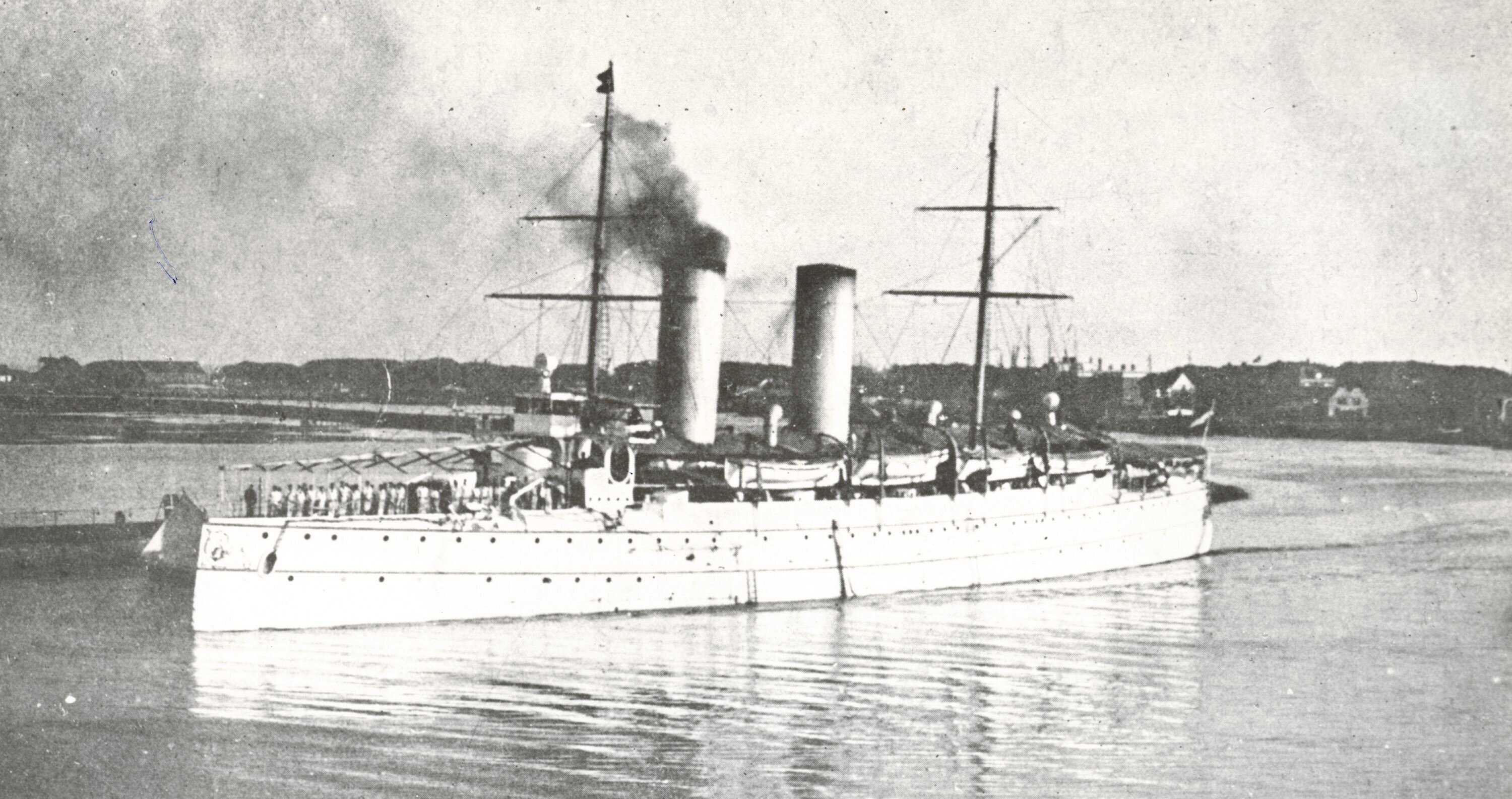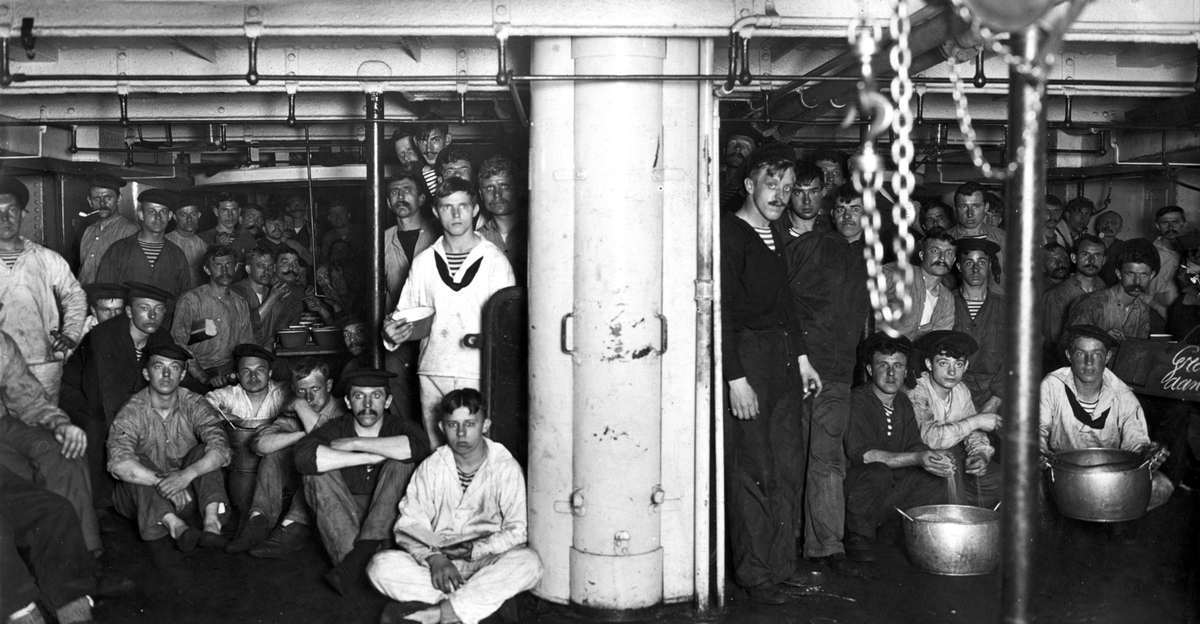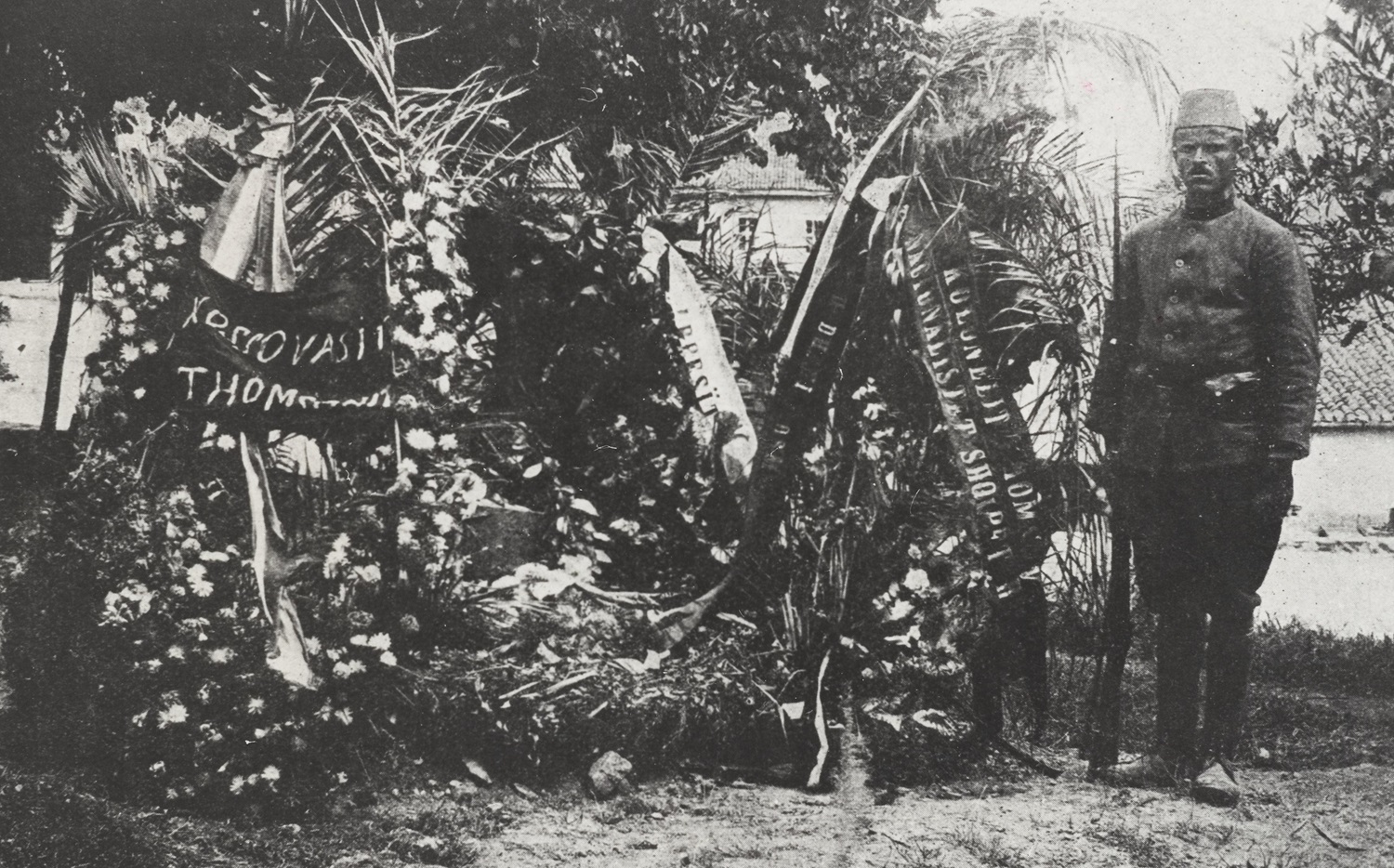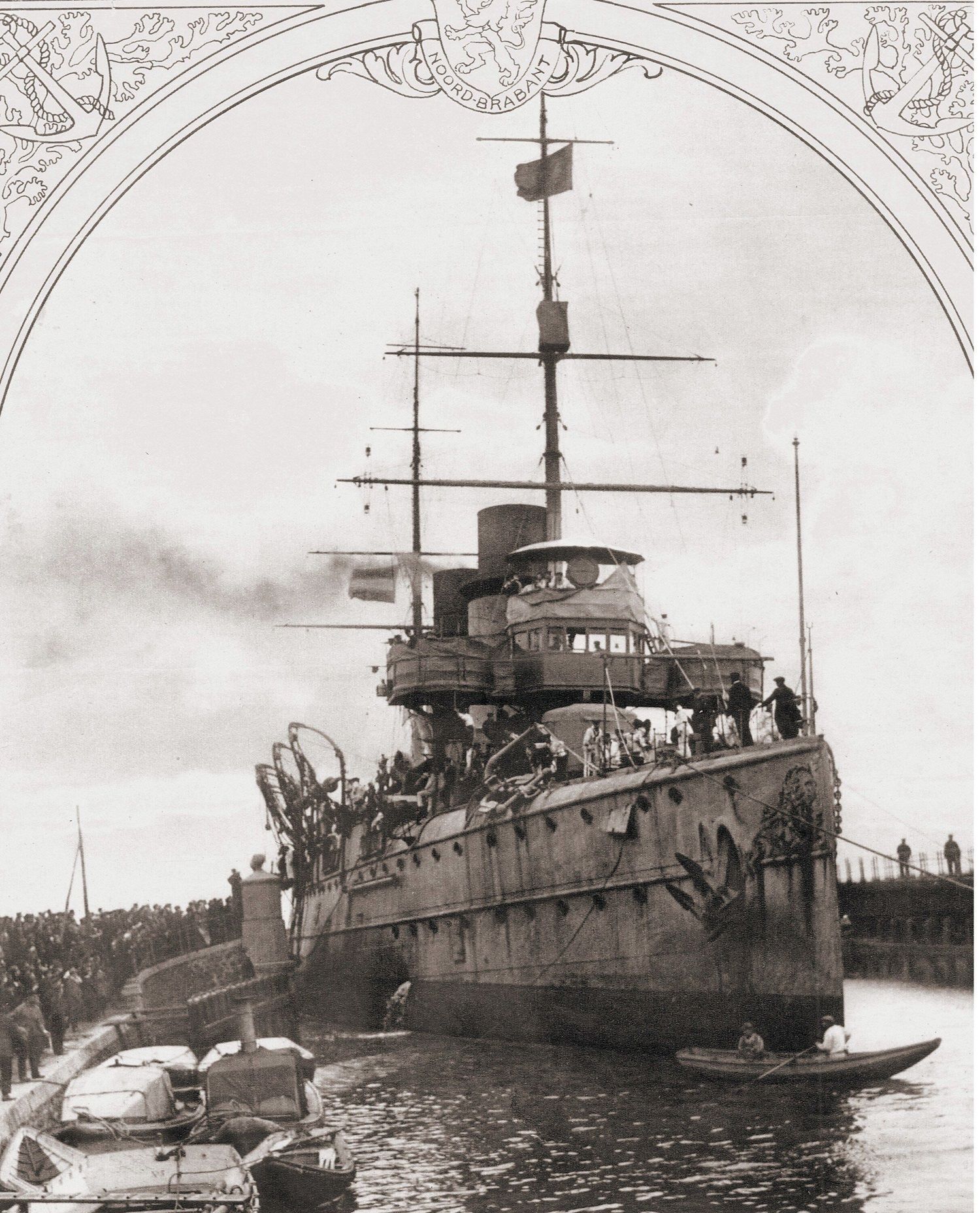Warship Wednesday, May 1, 2024: A Wandering Dutchman
Here at LSOZI, we take off every Wednesday for a look at the old steam/diesel navies of the 1833-1954 period and will profile a different ship each week. These ships have a life, a tale all their own, which sometimes takes them to the strangest places.- Christopher Eger
Warship Wednesday, May 1, 2024: A Wandering Dutchman

Image via the Koninklijke Marine Fotoafdrukken in the Netherlands Institute of Military History (NIMH), photo number NIMH 2158_010350.
Above we see the Holland-class pantserdekschip (armored cruiser) Hr.Ms. Noordbrabant steaming out of Den Helder for her inaugural deployment to the Dutch East Indies, on 28 January 1901, leaving a crowd of well-wishers ashore. Note the scrollwork on her gleaming white bow and large naval ensign.
She would see much overseas work, including some early peacekeeping, and would endure until the inferno of the 1940 blitzkrieg of the Netherlands.
The Hollands
The Hollands were the Dutch answer to the Royal Navy’s Apollo-class second-class protected cruisers (3,600-ton, 19.75 kts, 6×6-inch, 6×4.7-inch) and the class leader was ordered in 1894.
The first flight of three cruisers (Holland, Zeeland, and Friesland) had a displacement of 3,840 tons while the second batch (of which Gelderland was the lead followed by Noord Brabant and Utrecht) went 4,100 tons as they held 12 Yarrow boilers as opposed to 8 in the original design and went just a couple feet longer, with maximum speed varying between 18 and 20 knots. To extend their range, they were fitted with an auxiliary sailing rig deemed fast enough to carry the ships at 7-8 knots.
They carried a thin coating of Harvey nickel steel armor including two inches covering the decks and four in the conning tower while the guns had shields and the engine room glacis had a five-inch belt.
They were handsome craft and could both show the Dutch flag in the Caribbean-protecting the Netherlands Antilles, the Pacific where Holland held the sprawling Netherlands East Indies, and of course in metropolitan waters in Europe.
The main battery consisted of two 14.9 cm L/37 (5.86″/37 cal) Krupp No. 3 guns– which was essentially an export model of the German Navy’s extensively used 15 cm/40 (5.9″) SK L/40— arranged one fore and one aft behind 6-inch armored gun shields. The secondary battery consisted of a half-dozen 12 cm L/37 (4.72″/37 cal) Krupp No. 3 singles, typically with 1-inch gun shields. Tierciary anti-boat armament came in the form of six 75mm/37cal Krupp No.1 deck guns while an impressive array of a dozen 37mm Hotchkiss 1-pounders (including eight RF breechloaders and four Gatling guns) were ready for the light stuff.
For heavy anti-ship work, the Hollands carried a pair of submerged 17.7-inch torpedo tubes, bow and stern, although the below plans of Noordbrabant would seem to imply a set of amidships black powder charged torpedo guns just above the waterline– which may have been a tactical surprise as that feature isn’t listed in any of the period naval journals.
They were fetching ships, especially in their original all-white scheme.
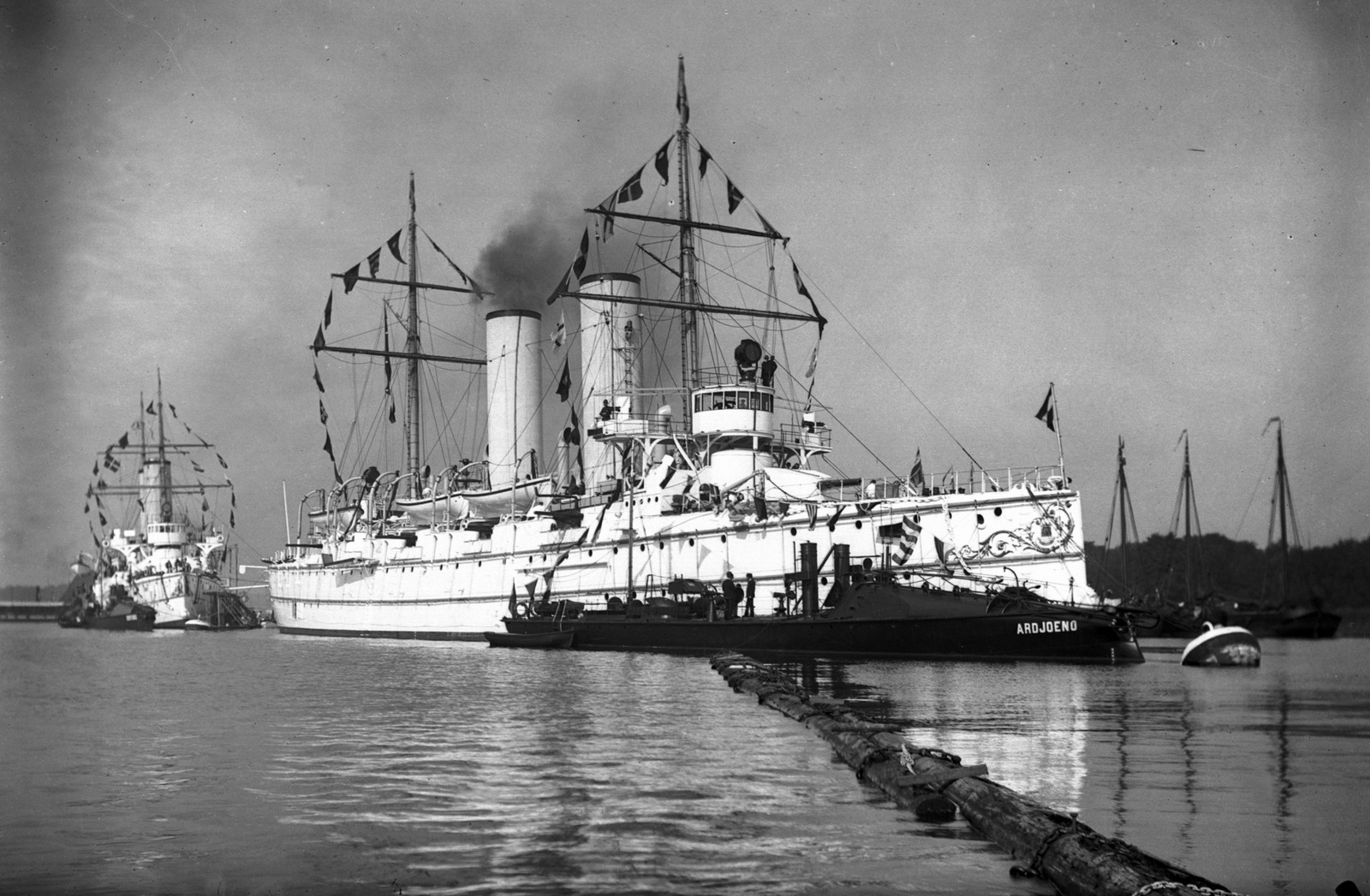
Amsterdam, August-September 1898, the inauguration Hr.Ms. Queen Wilhelmina, showing new pantserdek ships Holland and Zeeland along with the torpedo boat Ardjoeno. Note the revolving Hotchkiss cannon on the bridge wings of Holland and the large searchlight atop her wheelhouse.
Meet Noordbrabant
Our subject, named like the rest of her class for Dutch provinces, was laid down for the Dutch Navy on 31 August 1897 at the Koninklijke Maatschappij de Schelde, Flushing, launched 17 January 1899, and commissioned 1 March 1900, with a total construction cost of ƒ 3.045.607,00.
Pre-War Colonial Service
Noordbrabant was almost immediately sent aboard, her first “dance” being the Kiel regatta the summer she was commissioned, where she hosted the Kaiser himself.
In February 1901, she set off for a four-year deployment to the Dutch East Indies with sisters Gelderland and Utrecht.

(Lef to right) The Dutch East Indies squadron in profile showing the pantserdekschepen Hr.Ms. Noordbrabant, Hr.Ms. Gelderland, Hr.Ms. Utrecht, and Hr.Ms. Regentes along with the flottieljevaartuig (colonial gunboat) Hr.Ms. Nias in Sabang Bay on the island of Pulau, North Sumatra, circa 1902-1904. NIMH 2000-1385-041
It was during this extended deployment to the South Pacific that she called on Australia, Singapore, and Indochina then, on her return cruise back to the Netherlands for refit in 1905, would make calls at Perim, Port Said, Algiers, and Tangiers.

Pantserdekschip Hr.Ms. Noordbrabant is seen in a visit to Algiers, circa 1905. Note most of her awning frame has been taken down. NIMH 2158_010358
Her 1905-06 refit included removing her auxiliary sail rig and installing new generators for ventilation fans, shell lifts, and electric lights. Her armament was also homogenized, landing her two 5.86″/37s in favor of a full 10-gun battery of 4.72″/37 guns. Likewise, her 75mm/37cal and 37mm batteries were much reduced (from 6 and 12 to 2 and 4, respectively) and a 75mm mortar was installed for use in both lobbing star shells and in shore bombardment– though useful in her work in the Pacific.
After some calm duty in European waters, with occasional sorties into Scandinavian and Mediterranean waters, Noordbrabrant would again be sent to the Pacific for another tour in 1908 that would include calling at San Francisco in October 1909, as well as Hawaii.
While in the Bali Strait on gunnery exercises on 31 May 1910, she reefed on an uncharted rock and had two be lightened to be pulled off.
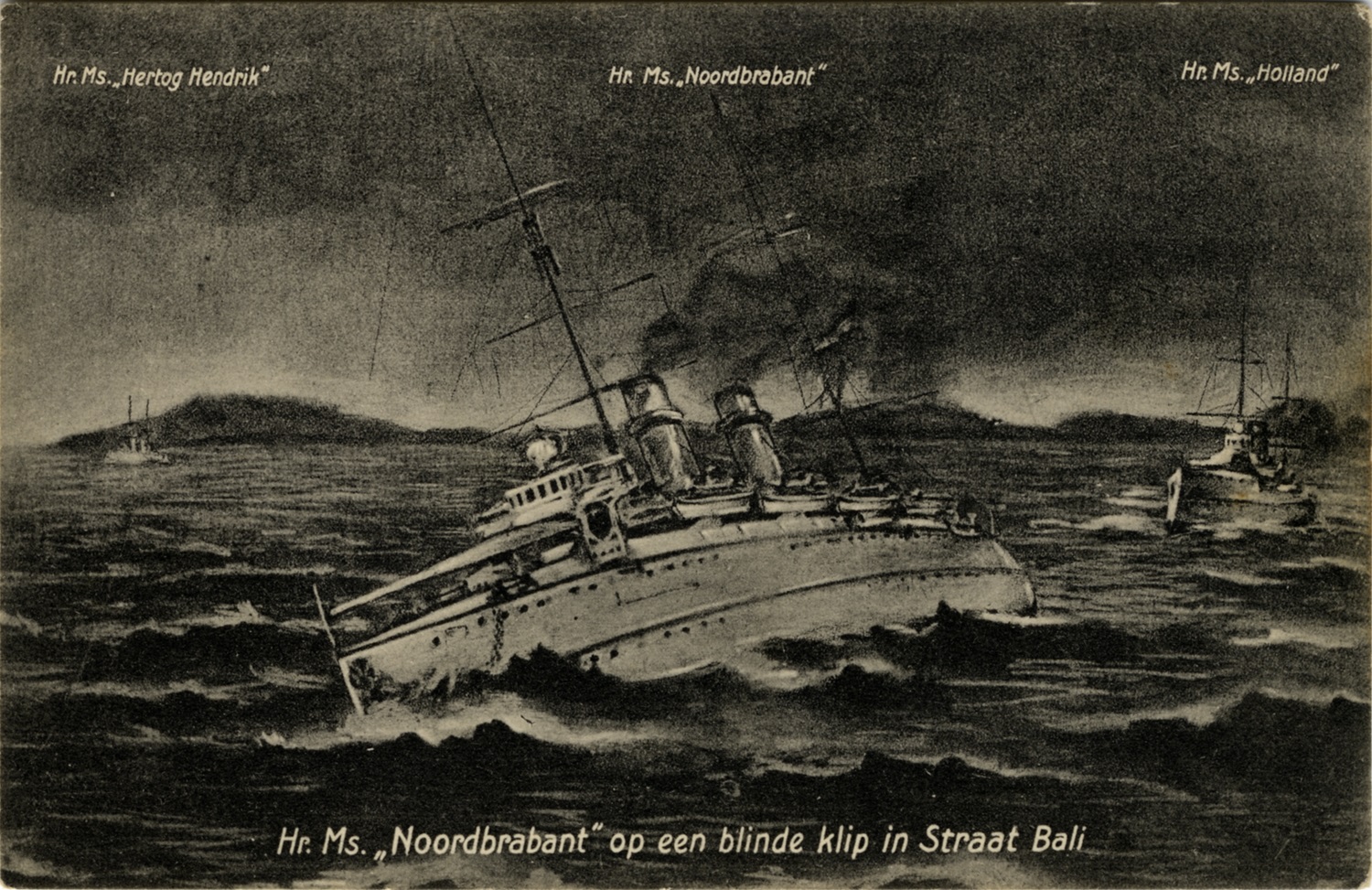
Hr.Ms. Noordbrabant hard aground on a reef in Bali Strait, with Hr.Ms. Hertog Hendrik and Hr.Ms. Holland standing by to assist.
Steaming to Soerabaja under her own power, once dry docked, it was found that she suffered a gash across two frames and required six months in repairs before taking to the sea once again.
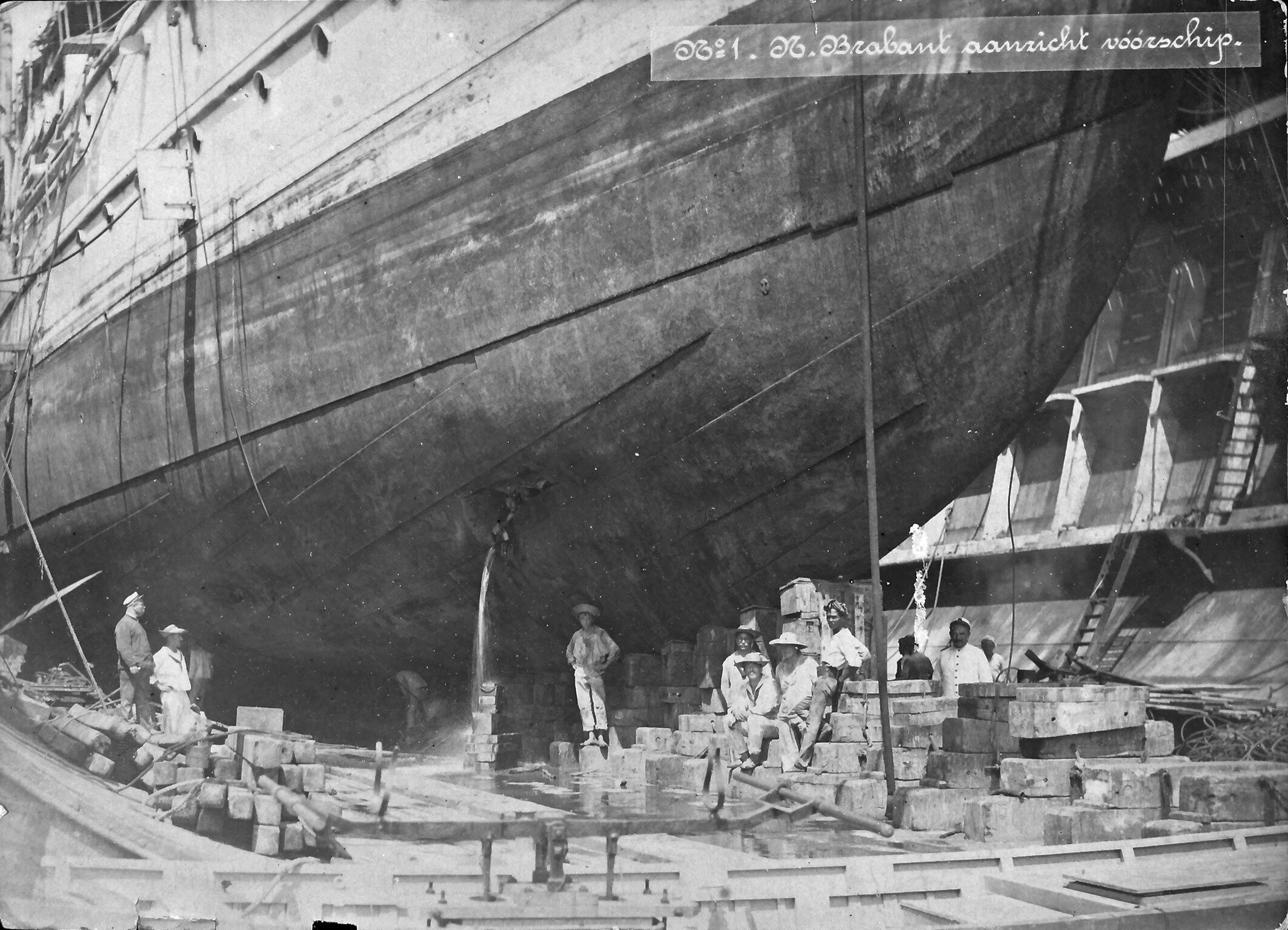
Damage to the bow sustained by Noordbrabant during a trip to the Soenda Islands (Lombok, 1910), while in dry dock in Surabaya, Java. NIMH 2158_090652

Noordbrabant with dark stacks and extensive canvas awnings, in Surabaya with accommodation ship Koning der Nederlanden to the left corner. Her apparent list could be due to damage. NIMH 2158_010349
She returned home from her second Pacific tour in June 1913.
Peacekeeping
In November 1913, the freshly-refit Noordbrabant carried the Dutch military mission to the burgeoning state of Albania, which had been established in the aftermath of the Balkan Wars by the six Great Powers at the London Conference the previous June.
The mission, consisting of 13 Army field officers (joined by another 11 the following February), was to form the fresh new country’s police force, a tall order considering the region was awash with Greek, Bulgarian, Italian, Kosovar, and Mirdita irregulars, bandits of all stripes, and some 200 Ottoman troops of Essad Pasha’s gendarmerie who were in no hurry to leave.

Off the Balkans, 1913-1914, before the outbreak of the war. Royal Netherlands Army officers aboard Noord-Brabant including (left to right) Major Kroon, skipper Ktz Oudemans, Gen. De Veer, and Major Roelfsema. Note the 4.72″/37 deck gun, lacking its sheifd. NIMH AKL000310.
Major Lodewijk Willem Johan Karel Thomson, a regular Dutch Army officer with some 30 years of service behind him including winning the Order of William during the Aceh War in the Far East, was made commander of the new International Gendarmerie of the Principality of Albania, which had planned to grow to a 5,000 member force carefully cultivated by the Dutch.
The plan was doomed to fail, with a series of peasant revolts instigated by outside powers leading to a clash at Durres on 15 June 1914 that left Thomson dead, and many of his fellow officers (briefly) captured. The Gendarmerie was taken over by Austrian and German officers who arrived two weeks later and shortly afterward was disbanded.
Thomson was initially buried in Albania, with full military honors and a fez-clad honor guard of his International Gendarmerie on post.
However, it was decided to repatriate his remains home, with the rest of the returning Dutch military mission. They were carried back by Noord-Brabant.
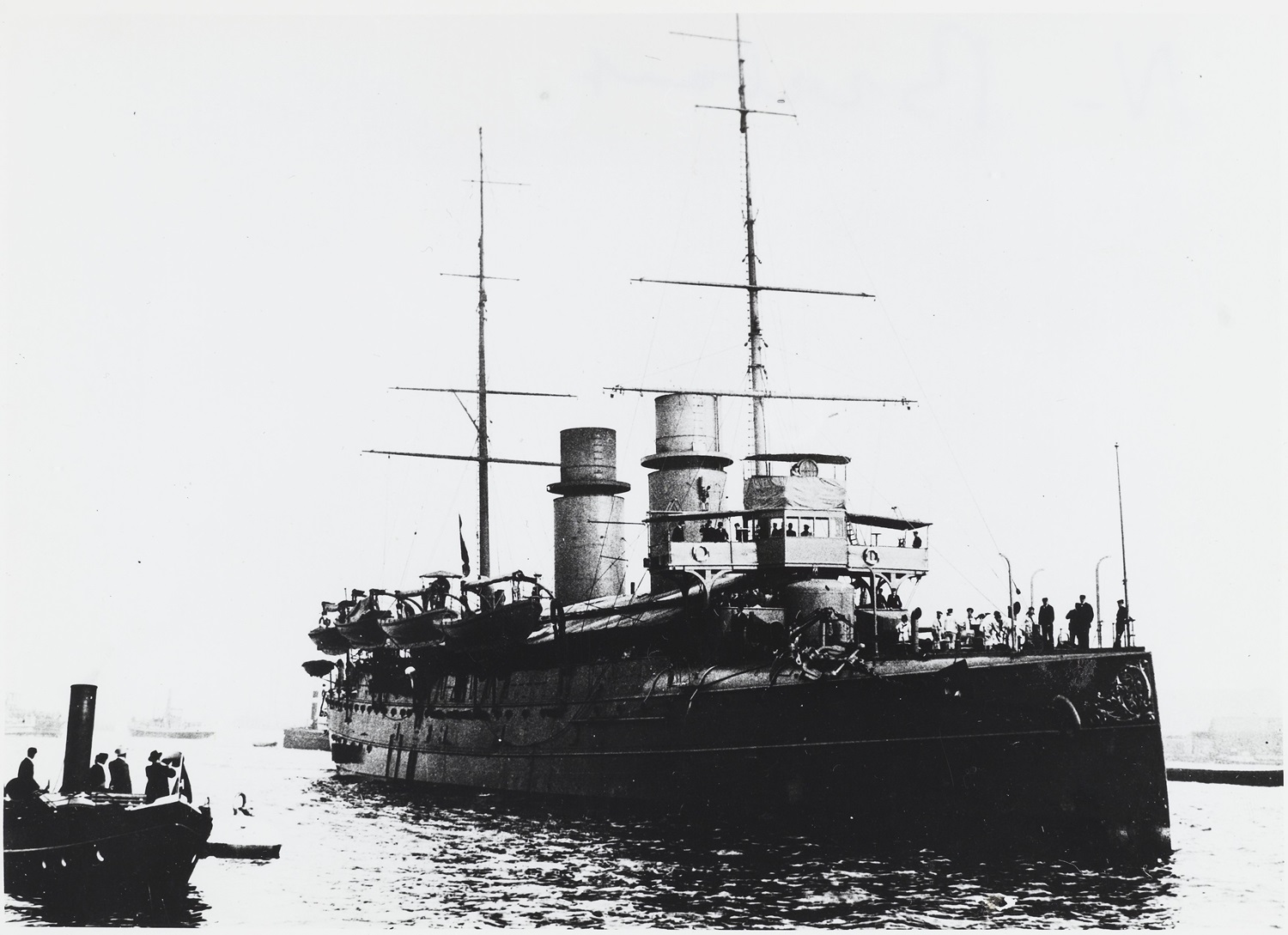
De kruiser Hr.Ms. Noord-Brabant vaart de sluizen van IJmuiden binnen, met aan boord het stoffelijk overschot van L.W.J.K. Thomson. 14 July 1914. Note the canvas covering on her bridge wings and her dark scheme. NIMH AKL000307

Noord-Brabant delivered the remains of Major Thomson to IJmuiden, Netherlands, on 14 July 1914, with his casket being carried by an honor guard of sailors.

Schilderij van de aankomst van het stoffelijk overschot van lkol L.W.J.K.Thomson met het Noord-Brabant te Amsterdam. NIMH AKL001364
Ultimately, Thomsom was re-buried with great public ceremony in Groningen and is seen as the first of a long line of Dutch peacekeepers killed overseas including no less than 28 who have perished on UN missions since 1949, primarily in Lebanon (UNIFIL), Mali (MINUSMA) and, ironically, the Balkans (UNPROFOR).
War!
A cautious neutral since 1830, the Netherlands spent the Great War walking a careful line. Although outwardly friendly to the Germans– Queen Wilhelmina’s husband was a German prince, Anthony Fokker set up a factory in Germany to produce what went on to become a legendary line of fighter planes, and the Kaiser would ultimately retire into exile in Holland in 1918– the country also had sympathy for their occupied neighbors in Belgium (there were over a million Belgian refugees in the Netherlands by Christmas 1914 along with 30,000 escaped Belgian soldiers) as well as close ties to France and Britain (the majority of the British 1st Royal Naval Brigade was interned in Holland).
To enforce their neutrality, on 31 July 1914, the Dutch government ordered full mobilization, putting both the Army and Navy on a war footing.
However, as classmates Friesland and Utrecht were decommissioned in 1913 before the conflict and had been scrapped already, the country had just four Hollands left on the navy list.

The four remaining Holland class cruisers in the 1914 Jane’s entry. The armament listed was the original circa 1900 fit, rather than what was refit in 1906
While something like 300 Dutch mariners and fishermen lost their lives offshore to both the Germans and the British, the Dutch navy did what it could to police their territorial waters against all comers while standing by to assist survivors of the conflict found in need.
One such incident involved Noordbrabant who, while on patrol in January 1916, encountered the foundering HM Submarine E17 a sandbank off Texel Island.
As noted by RN Subs:
E17, believing the Cruiser was belligerent submerged, but owing to the damage was forced to surface again. E1 signaled the unidentified cruiser for assistance and her crew was taken off and interned. E17 finally sank at 1140 on Thursday 6th January 1916.
Rescuing all of E17’s 31 officers and ratings, led by LCDR John Robert Guy Moncrieffe, RN, Noordbrabant landed them at Den Helder from which they were later moved to Groningen where other Royal Navy internees were held for the duration.

Pantserdekschip Hr.Ms. Noordbrabant seen in her Great War paint scheme, circa 1916-18. NIMH 2158_010354

Another from the same period. Note her recognition stripes on her stacks and a good detail of her No. 1. mount. 2158_010353
Doldrums
Post-war, Noordbrabant was decommissioned in 1920 and laid up. Meanwhile, sisters Holland, and Zeeland, were likewise decommissioned and disposed of, while only Gelderland was retained in service– as a gunnery training ship.
Disarmed, from 1922 to December 1925, Noordbrabant was loaned to the Departement van Justitie as a logementschip (accommodation ship) for wayward youth and orphaned boys.
Returned to the Navy in January 1926, Noordbrabant was further modified and converted to a opleidingsschip (training ship) to be based at Vlissingen, where the old cruiser would become the first stop for new recruits (leerling-matroos= apprentice sailors) to learn seamanship, military bearing, and drill.
As such, most of the rates in the Dutch Navy for the next 15 years began their service on Noordbrabant’s decks.
She was given a topside makeover, with her empty gun mounts and superstructure covered by a deck house while her engine spaces– unneeded moving forward– were reduced to a single stack, used for venting cooking and heating exhausts.

Pantserdekschip Hr.Ms. Noordbrabant as a opleidingsschip (training ship) in Vlissingen. Note the large skylights in deck house. NIMH 2158_010373

The opperdek (quarterdeck) of Noordbrabant while she was being used as an accommodation ship at Vlissingen. Note the horseshoe buoy, Marines complete with short swords, a stand of Mannlicher rifles, and Navy bugler. The skylights can be seen above. NIMH 2158_010391
She hosted Queen Wilhelmina on 17 April 1931 for the official opening of the Buitenhaven, Vlissingen’s outer port which is still in use today.
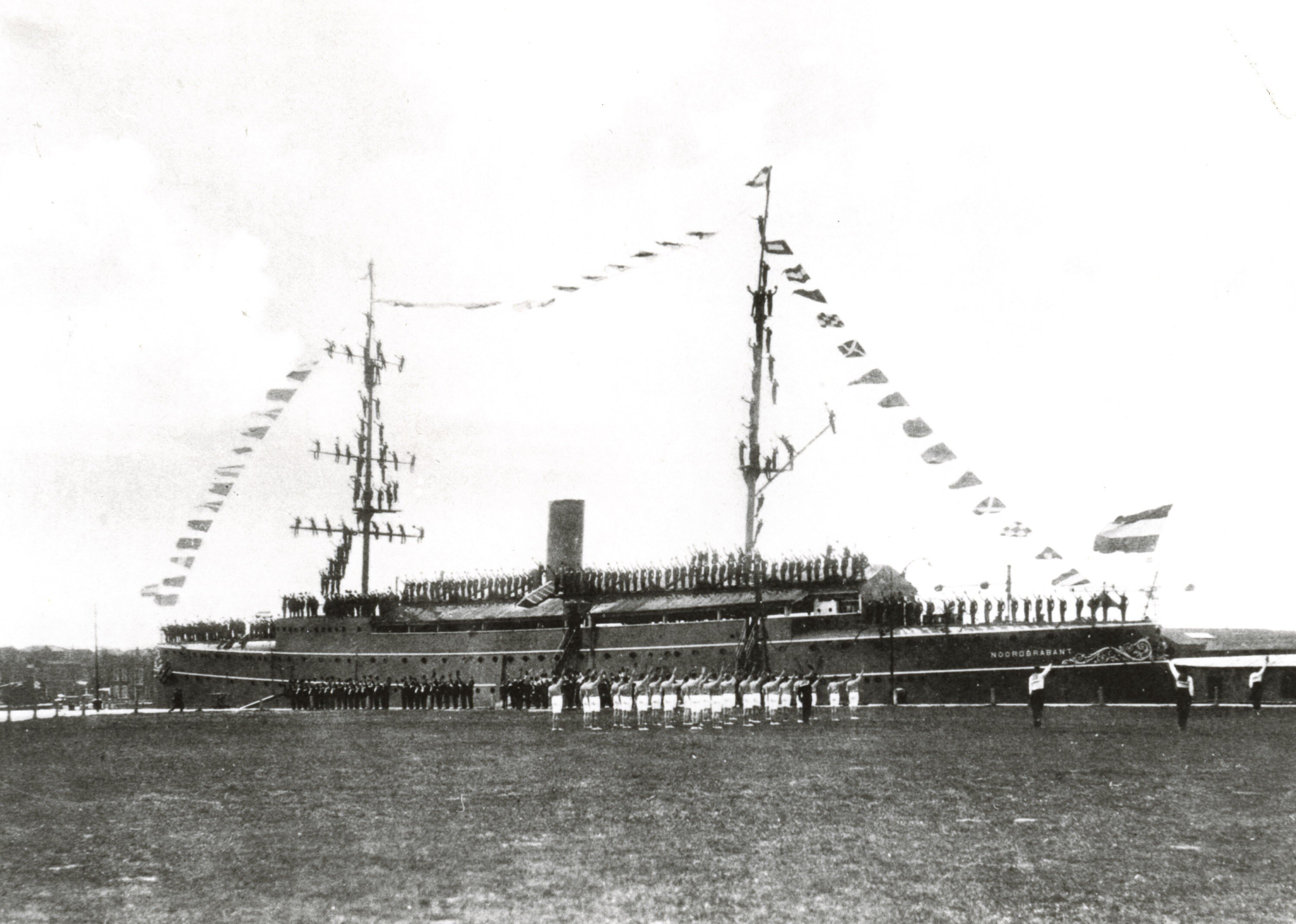
April 1931. Noordbrabant in Vlissingen with her glad rags flying. The crew cheers when HM Queen Wilhelmina disembarks after the visit. NIMH 2158_010372

Queen Wilhelmina inspected the crew of Noordbrabant in Vlissingen, in April 1931. Note the men on her yardarms and officers in full ceremonial dress including fore-and-aft bicorne hats, white gloves, and frock coats with braided epaulets. NIMH 2158_010370

Another of Queen Wilhemina leaving, escorted by VADM Laurentius Johannes Quant. Noordbrabant in the background. NIMH 2158_010369
War! (again)
Rated a wachtschip (guard ship), with a small battery of light 75mm guns aboard, Noordbrabant made ready for her second world war in 1939 even though her engine room had been a cold iron watch for almost two decades and her machinery had been looted to keep Gelderland running.
It should come as no surprise that, when the Germans closed on Vlissingen in May 1940, the only thing left for the crew of Noordbrabant to do was to burn her in place.

A crispy Noordbrabant seen as a wachtschip (guard ship), in September 1940 after the ship was set on fire by her crew crew on 17 May. NIMH 2158_010380
Post-war, her hulk was sold for scrap.
As for her last sister, Gelderland, she was captured by the Germans, converted to a floating anti-aircraft battery, and sunk in Finnish waters by the Red Air Force in 1944.
Epilogue
There are a few relics of our subject preserved.
Her cherished ship’s bell (scheepsklok) is in the Noord-brabant Provinciehuis at Hertogenbosch, alongside an information plaque.
The exquisitely detailed 83cm x l 190cm builder’s model from 1900 is in the collection of the Dutch Rijksmuseum.
She is also well remembered in maritime art.
The photo of a young Noordbrabant, steaming from Den Helder for the Far East in 1901, was turned into painting by maritime artist Flip Hammes in 1955.
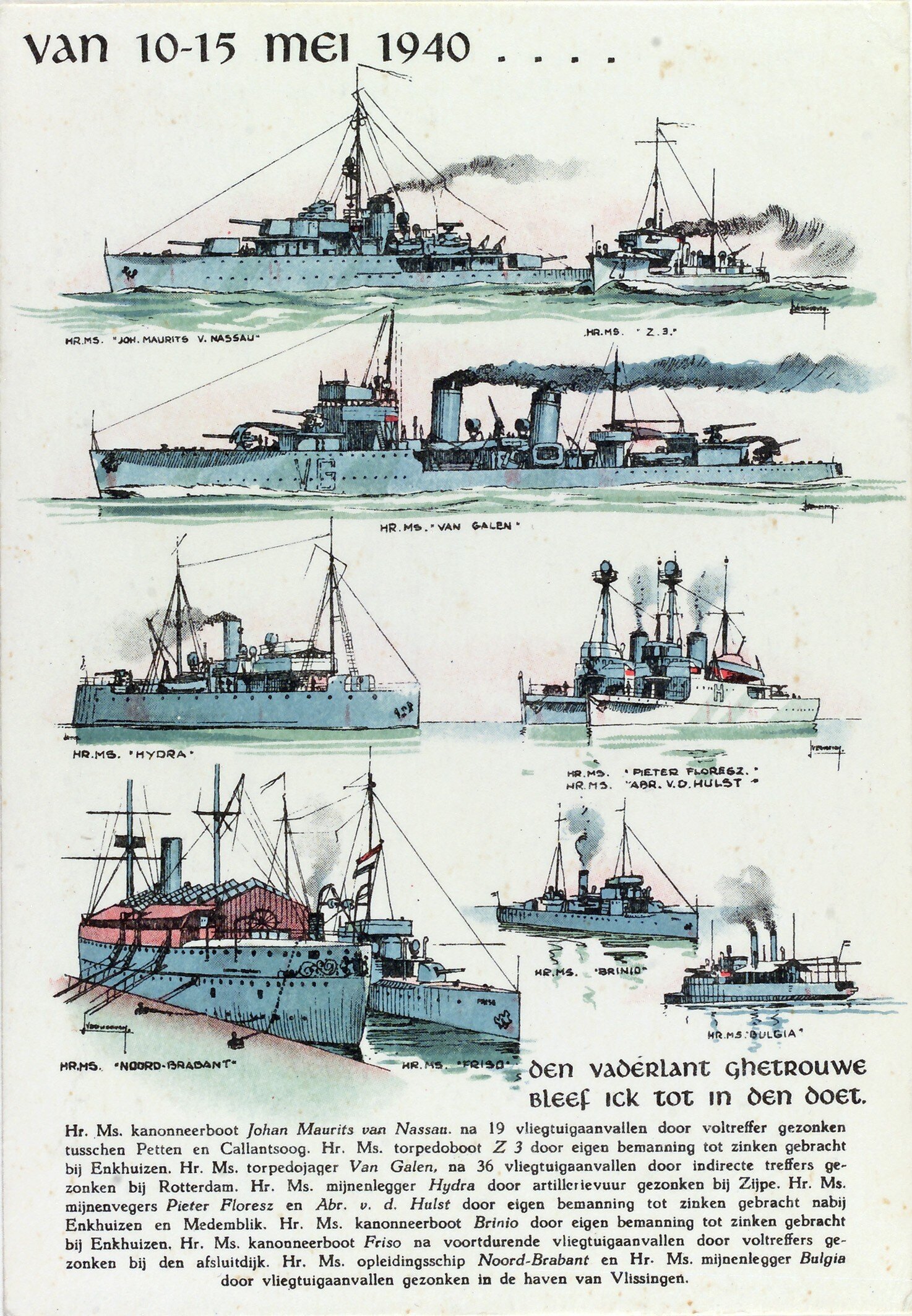
A 1950 Our Naval Committe postcard showing 10 Dutch warships lost between 10 and 15 May 1940 during the German attacks invasion including the kanoonneerboot Hr.Ms. Johan Maurits van Nassau flanked by the torpedoboot Hr.Ms. Z 3, the torpedobootjager (destroyer) Hr.Ms. Van Galen, mijnenlegger Hr.Ms. Hydra, mijnenvegers Hr.Ms. Pieter Florisz and Hr.Ms. Abraham van der Hulst, our Noord-Brabant in the bottom left with the kanonneerboot Hr.Ms. Friso alongside, as well as the kanonneerboot Hr.Ms. Brinio, and mijnenlegger Hr.Ms. Bulgia in the distance to the bottom right. NIMH 2158_090416
The Dutch Navy recycled her name in 1948 for a new 2,600-ton Holland class onderzeebootjager (destroyer) that would remain in service until 1974.
Ships are more than steel
and wood
And heart of burning coal,
For those who sail upon
them know
That some ships have a
soul.
If you liked this column, please consider joining the International Naval Research Organization (INRO), Publishers of Warship International
They are possibly one of the best sources of naval study, images, and fellowship you can find. http://www.warship.org/membership.htm
The International Naval Research Organization is a non-profit corporation dedicated to the encouragement of the study of naval vessels and their histories, principally in the era of iron and steel warships (about 1860 to date). Its purpose is to provide information and a means of contact for those interested in warships.
With more than 50 years of scholarship, Warship International, the written tome of the INRO has published hundreds of articles, most of which are unique in their sweep and subject.
PRINT still has its place. If you LOVE warships you should belong.
I’m a member, so should you be!


